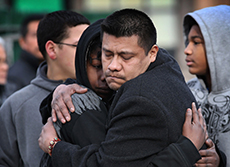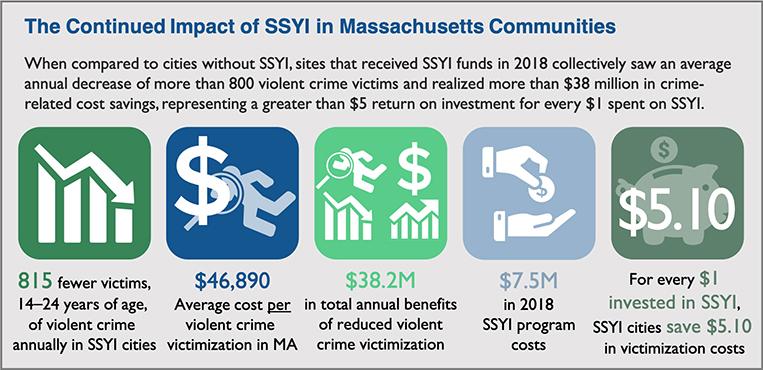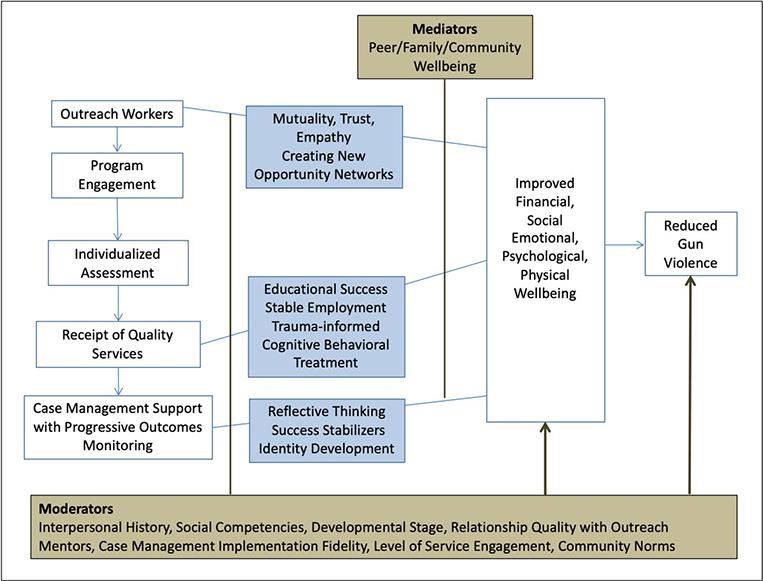Safe and Successful Youth Initiative in Massachusetts (SSYI)
 Youth violence presents significant challenges across the U.S., disrupts communities and economic development, increases health care costs, and decreases property values—not to mention the human impact. In 2010, Massachusetts was the most violent state in the Northeast—the MA Public Health Council reported 1,667 homicide victims between 2001 and 2010, with nearly 40 percent of them between ages 14 and 24.
Youth violence presents significant challenges across the U.S., disrupts communities and economic development, increases health care costs, and decreases property values—not to mention the human impact. In 2010, Massachusetts was the most violent state in the Northeast—the MA Public Health Council reported 1,667 homicide victims between 2001 and 2010, with nearly 40 percent of them between ages 14 and 24.
In 2010, building on more than a decade of statewide violence reduction efforts including Operation Ceasefire, Project Safe Neighborhoods, and the Shannon Community Safety Initiative, as well as city level efforts like the Boston Partners Advancing Communities Together (PACT) Initiative, Massachusetts developed an approach to reduce gun violence in cities with the highest per capita rates of violent crime.
The Safe and Successful Youth Initiative (SSYI) began in 2011 as a signature program under the governor’s office and has since operated within the Executive Office of Health and Human Services (EOHHS). Originally launched in 11 cities and focused on youth ages 14 to 24, SSYI is a multifaceted, community-based strategy that uses a public health approach, in partnership with law enforcement, to eliminate lethal and nonlethal violence among young people who have already committed, and often been the victim of, gun and gang violence (i.e., proven-risk youth). SSYI now operates in 14 cities across the state, serving nearly 2,000 clients ages 17 to 24 annually in communities that include Boston, Brockton, Chelsea, Fall River, Haverhill, Holyoke, Lawrence, Lowell, Lynn, New Bedford, North Adams, Pittsfield, Springfield, and Worcester.
Since SSYI's inception, AIR and WestEd have served as the statewide evaluator for the initiative. The AIR-WestEd team has produced numerous articles, briefs, and reports, including cost-benefit studies, that demonstrate SSYI’s effectiveness and broader evidence reviews examining Massachusetts' unique statewide approach to violence prevention.
Evaluation of SSYI
In December 2014, then-Massachusetts Governor Deval Patrick released an AIR evaluation report including three outcome studies of SSYI. The evaluation illustrated positive benefits to the young people involved in the program. For example, compared with youth and young adults who were actively engaged in SSYI services, youth and young adults who were not involved in SSYI, but had similar violent crime backgrounds, were 42% more likely to be incarcerated.
Since SSYI’s inception, rates of violent offenses and victimization in non-SSYI cities saw modest decreases or were relatively stable. Conversely, in cities with SSYI funding, rates have steadily declined since 2012. The findings from AIR’s most recent evaluation highlight SSYI’s positive impact on community and individual level crime and a return on investment (see below), as well as on the lives of participants. For example, after 2012, clients enrolled in SSYI had 36 percent fewer violent offenses and 20 percent fewer non-violent offenses than did young men identified for the program who never enrolled. Further, self-reported survey data from SSYI clients shows that SSYI provides these young men with resources and supports they value, if not depend on and participation in SSYI facilitates meaningful changes in the lives of participants that decrease their likelihood for future involvement with violence and improve their prospects for future personal, social, economic, and physical wellbeing.

AIR will release updated evaluation results focused on the impact of SSYI’s core components—street outreach, case planning and management, and needs-based service engagement—later this year.
The latest AIR-WestEd study of SSYI is exploring the client-level impacts of SSYI’s outreach, case management, and services targeted to meet each client’s priority needs. Using lifetime offending histories and client case management data, the study is examining the core components of SSYI’s Theory of Change, developed through previous evaluations of the initiative. Study findings will be released in fall 2021.
SSYI Theory of Change

The Promise of SSYI in Massachusetts and Beyond
Within the environment of SSYI’s success, Massachusetts is actively exploring ways to develop cross-initiative evaluation strategies across programs like the Department of Public Safety’s Shannon Community Safety Initiative targeting secondary risk populations and the Department of Public Health’s Child and Youth Violence Prevention Services initiative. The commonwealth’s investment in this expanded approach to violence prevention across a risk continuum, from primary to tertiary risk populations, has also pioneered the way for other states to develop comprehensive statewide approaches to violence prevention. Several states have looked to the SSYI model—both in how the program serves and supports clients and in how the state provides the funds and infrastructure (including ongoing evaluation and technical assistance) necessary to support sustainable implementation—as a means to advance their own violence prevention efforts. Learn more.
Best Practice Review of Evidence
As part of the SSYI study, AIR and WestEd conducted a best practice review of evidence about the effectiveness of violence prevention programs targeted at urban youth. The findings are detailed in What Works to Prevent Urban Violence Among Proven Risk Young Men? The Safe and Successful Youth Initiative (SSYI) Evidence and Implementation Review (PDF).
The best practice review of evidence, conducted through a Rapid Evidence Assessment, identified ten effective programs reporting at least a ten percent reduction in violent incidents. These programs shared two common features: use of street outreach workers and connections with community services for high-risk youth (e.g., help finding work and earning a GED).
The review of evidence indicates the importance of integrating an array of community services rather than just addressing gang-related issues. It also makes eight recommendations to guide violence prevention implementation and evaluation of impacts.
Recommendations to Guide Violence Prevention Implementation and Evaluation of Impacts
- Focus on youth at highest risk for future violence.
- Pay attention to youth on the cusp of highest risk, even if they are not yet classified as proven risk.
- Effectively communicate to targeted offenders that they will receive services to help them leave the criminal lifestyle.
- Train and supervise outreach workers to minimize “backfire” effects, which can unintentionally increase gang activity.
- Implement programs with adequate staff, resources and expertise.
- Collaborate with multiple city agencies and community members, including business leaders with organizational management expertise.
- Use data continuously to strategically address population shifts and violence drivers.
- Conduct long-term studies to calculate returns on investment, accounting for broader (and generational) contexts.
Reports from the SSYI Evaluation
Understanding the Influence of Outreach, Case Management, and Service Engagement on Interrupting Community Violence
Since its inception, the SSYI has shown promise for reducing violent crime at the community level in Massachusetts. This report details the most recent study conducted by AIR and partners at WestEd to evaluate the impact of SSYI on individuals. Using extant data on offense history and client case management records, the study explored four key questions that examine client recidivism outcomes affected by the dosage and cumulative impact of SSYI client outreach, case management, and service engagement strategies.
Safe and Successful Youth Initiative (SSYI) Evaluation: 2018–19 Final Programmatic Report (PDF)
Since SSYI’s inception, rates of violent offenses and victimization have steadily declined in cities with SSYI funding as to comparable cities without SSYI. Further SSYI clients have had fewer violent offenses (and non-violent offenses) than young men identified for the program who never enrolled and report that participation in SSYI facilitates meaningful changes in their lives that decrease their likelihood for future involvement with violence and improve their prospects for future personal, social, economic, and physical wellbeing.
Community-Based Violence Prevention Study of the Safe and Successful Youth Initiative: An Intervention to Prevent Urban Gun Violence (PDF)
The causes and drivers of youth violence are complex—related to many variables including poverty, racism, and lack of education, training, and opportunity. The AIR-WestEd team examined SSYI’s impact on community-level changes in violent crime over an eight-year period (2007-2014) explored the complexities of community relationships and the central role that race and changing population demographics have on the way the justice system interacts with young men of color at the greatest risk for gun violence and those living in economically vulnerable communities.
The Impact of the Safe and Successful Youth Initiative on City-Level Youth Crime Victimization Rates (PDF)
The AIR-WestEd team conducted an Interrupted Time Series analysis to study SSYI’s effectiveness by analyzing community crime victimization from 2011 to 2013 in the 11 SSYI cities compared to non-SSYI cities across the state. We found that the SSYI cities saw a reduction of more than 5 violent crime victims per month for every 100,000 residents, representing more than 980 victimizations prevented from 2011 to 2013.
A Comparative Study Using Propensity Score Matching to Predict Incarceration Likelihoods Among SSYI and non-SSYI Youth from 2011-2013 (PDF)
Researchers used a Propensity Score Matching technique to examine individual outcomes for youth involved in SSYI and found that youth engaged in SSYI were 58% less likely to be re-incarcerated when compared with other youth in the community with similar violent crime histories.
Massachusetts Safe and Successful Youth Initiative: Benefit-to-Cost Analysis of Springfield and Boston Sites (PDF)
When a dollar value is applied to the benefits of crime reductions from SSYI in Boston and Springfield alone, research indicates a savings in incarceration, hospital, and other costs of almost $15 million based on investment in the SSYI program in these two cities from 2011 to 2013.
Additional Reports and Articles
- The Impact of the Safe and Successful Youth Initiative on City-Level Youth Crime Victimization Rates: Substantive Results and Implications for Evaluation, Journal of MultiDisciplinary Evaluation, 13 (29), 9–14
- Cross-sector, Multi-agency Interventions to Address Urban Youth Firearms Violence: A Rapid Evidence Assessment (available with subscription or for purchase), Aggression and Violent Behavior, 22, May–June 2015, 87–96
- Strategies to Prevent Urban Violence
- Practice Guidelines for the Delivery of Trauma-Informed and GLBTQ Culturally-Competent Care
- What Works to Prevent Urban Violence Among Proven Risk Young Men? The Safe and Successful Youth Initiative Evidence and Implementation Review

